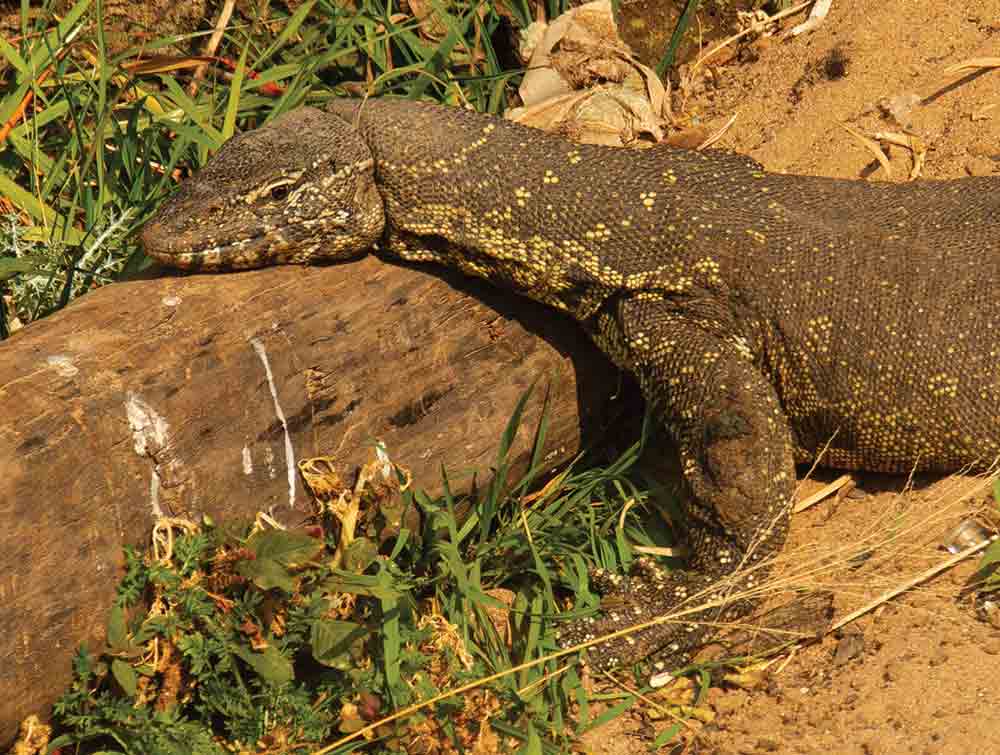Through this rescue mission, we have used it to make the residents of the estate more aware of the litter issue.
The Jukskei river runs through a large wildlife estate, the Waterfall Estate in Midrand, an area just outside of the city of Johannesburg, South Africa. A rich riparian habitat accompanied by extensive grasslands in this estate, provides a safe haven for the remaining wildlife. All indigenous flora and fauna are protected on the estate and over the last few years the Nile monitors (Varanus niloticus) have bred successfully and are abundant.
Urbanization has resulted in large amounts of litter and debris being washed though the drainage lines which form part of the Egoli grassland system, and this preempted the environmental council in the Waterfall Estate to erect a litter catchment area further up river, made of concrete and steel, so as to reduce the impact of pollution on the ecosystem and wildlife in the estate.
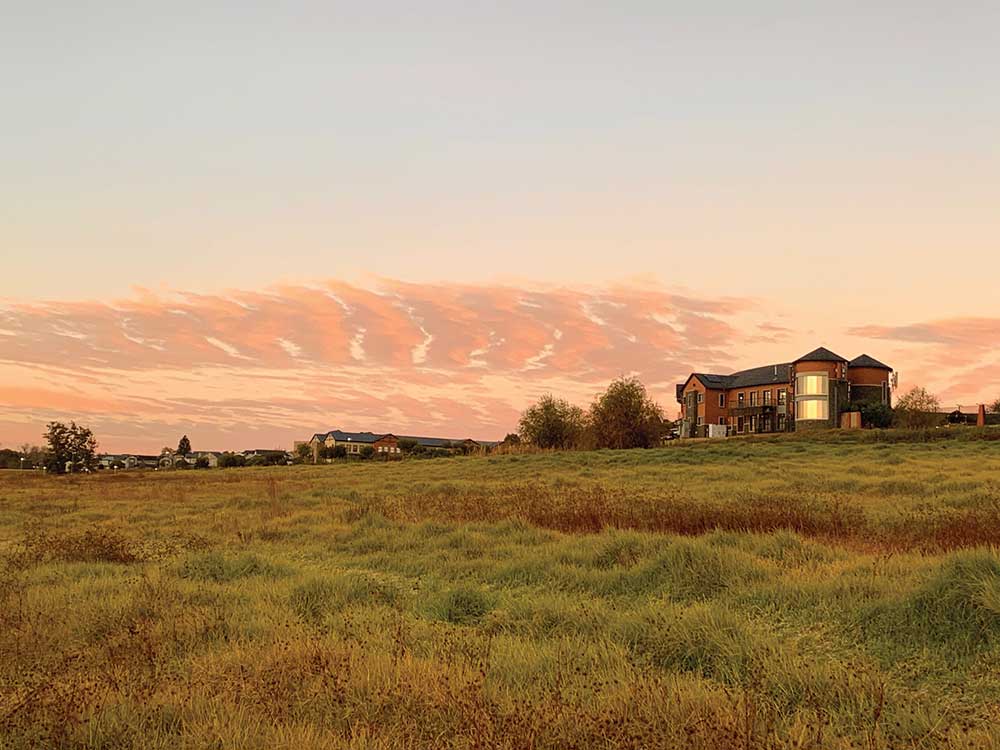
The Waterfall Estate in South Africa. Photo by Dr. Ingrid Sellschop
The estate is home to many diverse plant species, birdlife and wildlife, including a variety of reptiles such as snakes, lizards, turtles and tortoises. A wildlife NGO often uses the estate for the safe release of the leopard tortoise (Stygmochelys pardalis), which are now breeding successfully.
In the Field Observing the Nile Monitor
Being a passionate wildlife photographer and volunteer conservationist in my spare time, and residing in the Waterfall Estate, I enjoy observing and photographing the behavior of Nile monitors. A few of my experiences in the field have been photographing and filming monitors in action. I watched a very large female Nile monitor digging into a termite mound and laying her eggs during the month of June; their breeding season ranges from June to October and they are often seen during this time period as the males are actively seeking out a mate. The female will lay between 20-60 eggs in a hole or a termite mound. I returned to the nesting site the following day to find a another, younger Nile monitor predating on the eggs within the termite mound. It fed for two days on the eggs, sleeping overnight within the termite mound.
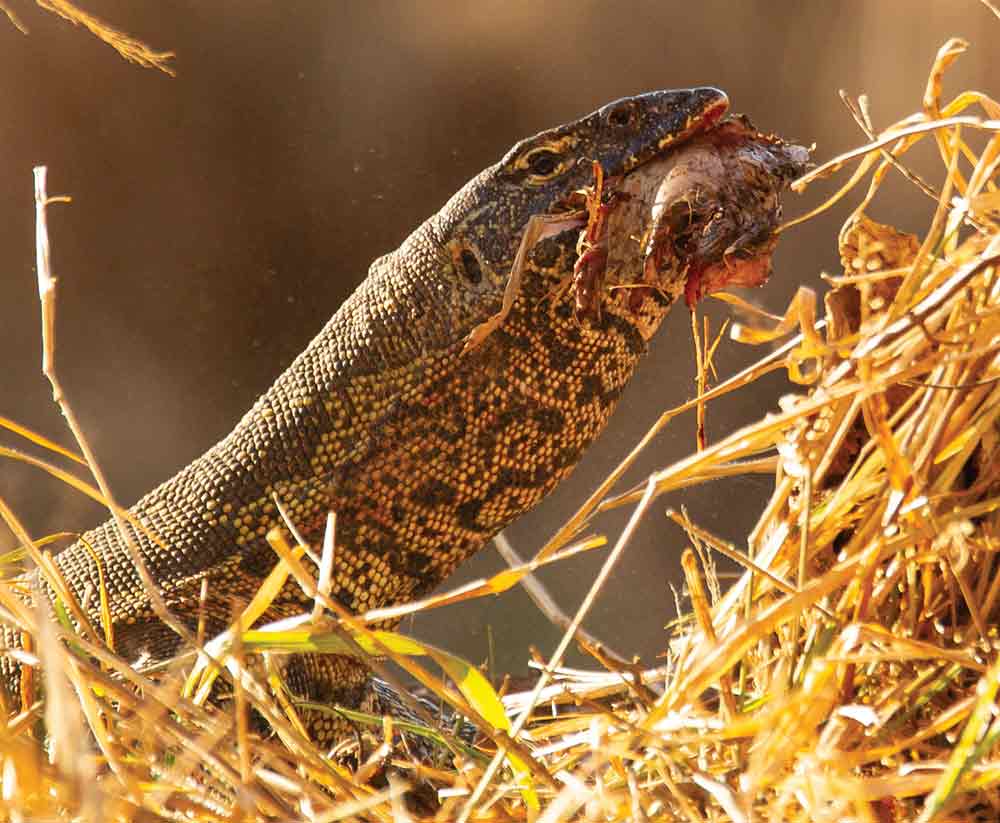
Nile monitor with prey. Photo by Dr. Ingrid Sellschop
One afternoon, I was observing the “bank” of monitors ( a group of monitors is referred to as a ‘bank’ of monitors) along the river in the estate, when movement in the forest above the river caught my eye. I decided to cross the river and go and investigate and found that a very large Nile monitor was moving through the foliage, carrying the remains of a porcupine (Hystrix africae australis). These large lizards are both scavengers and predators, and they have been known to feed on a large variety of prey items such as rodents, other reptiles, amphibians, insects, crabs, mollusks, fish and birds.
Study Highlights Marine Plastic Ingestion In Sea Turtles
On the odd occasion the larger of the monitors will feed on small mammals, such as a porcupine. The large monitor in the action of feeding on the porcupine amongst the foliage was quite gruesome to photograph but fascinating to see it devouring the meat along with the porcupine quills. During the time of carrying its prey through the foliage, five other monitors from the burrows along the river started arriving in the forest, seeking out the smell of prey.
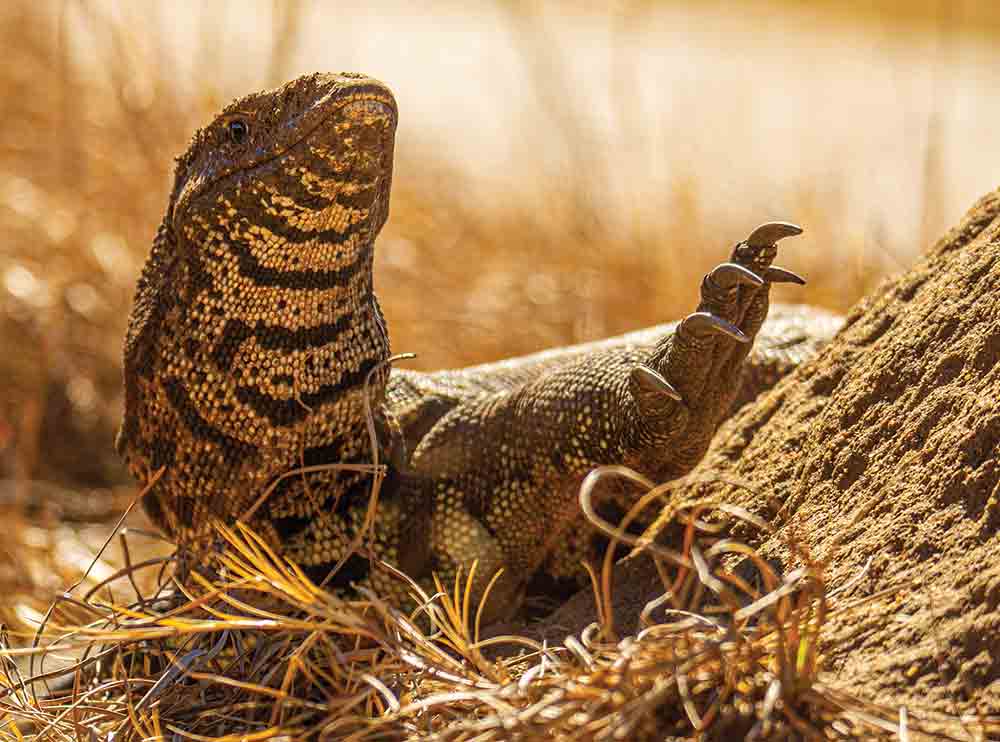
This Nile monitor is about to have some termite eggs for lunch. Photo by Dr. Ingrid Sellschop
The forked tongues of these reptiles are highly sensitive to smell and aid them in finding their prey. As I continued to observe the situation taking place in front of me, I had to climb a tree to get out of the path of the monitors proceeding to move toward the large monitor with its prey. The predating monitor moved its head up and down in quick succession to warn off any approaching competition. The porcupine was fairly large and it took over an hour for the monitor to finally finish feeding on it.
Nile Monitor Rescue Mission in the Field
Through my regular observation of the Nile monitors along the river, where there is a section of at least 20 burrows that the monitors use and reside in, I recently noticed that one of the large Nile monitors had a plastic noose wrapped around its neck; in fact there were two parts to the noose: one part was tightly wound around the neck and throat area, while another wider loop could be seen above the first noose.
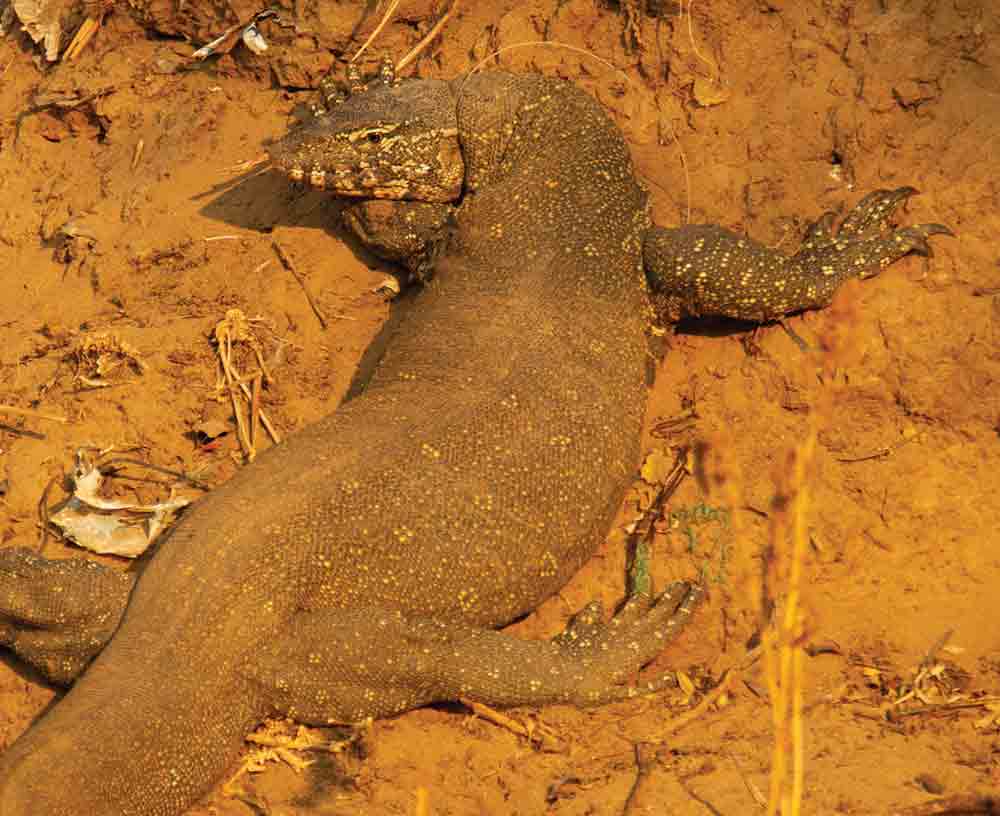
The restriction of the plastic noose is clearly visible in this photograph. Photo by Dr. Ingrid Sellschop
When feeding on large prey, the monitor’s throat area expands to allow the prey to slide down its throat. It was quite obvious that this particular monitor would only be able to feed on very small prey as the noose did not allow for any expansion. Subsequent to recognizing that this monitor was in danger of potentially starving to death in the long term, I alerted the environmentalist on the estate, Kevin Gow. He and his wife, Sue Gow, also a passionate conservationist, and I formed a team and planned a strategy to capture the monitor and release the plastic noose from around its neck. Our resident environmentalist, Kevin is highly skilled at handling reptiles and he is often called to safely relocate snakes from people’s residences in the estate, and hence, he was the best person to direct and be involved in the rescue mission.

A Cape wolf snake. Photo by Kevin Gow
Capturing monitors is not an easy task and often requires nets and a pole with a noose to aid the capture, as well as a team of people and adequate monitoring and timing. Last year a similar sighting of a monitor with the remains of a tin can around its neck was sighted but after organizing a team comprising a wildlife vet and three other volunteers, the monitor could not be found on the planned day of capture. The rescue mission had to be aborted, and it was assumed that with no sightings for weeks thereafter, that the monitor had moved further upstream out of the confines of the estate.
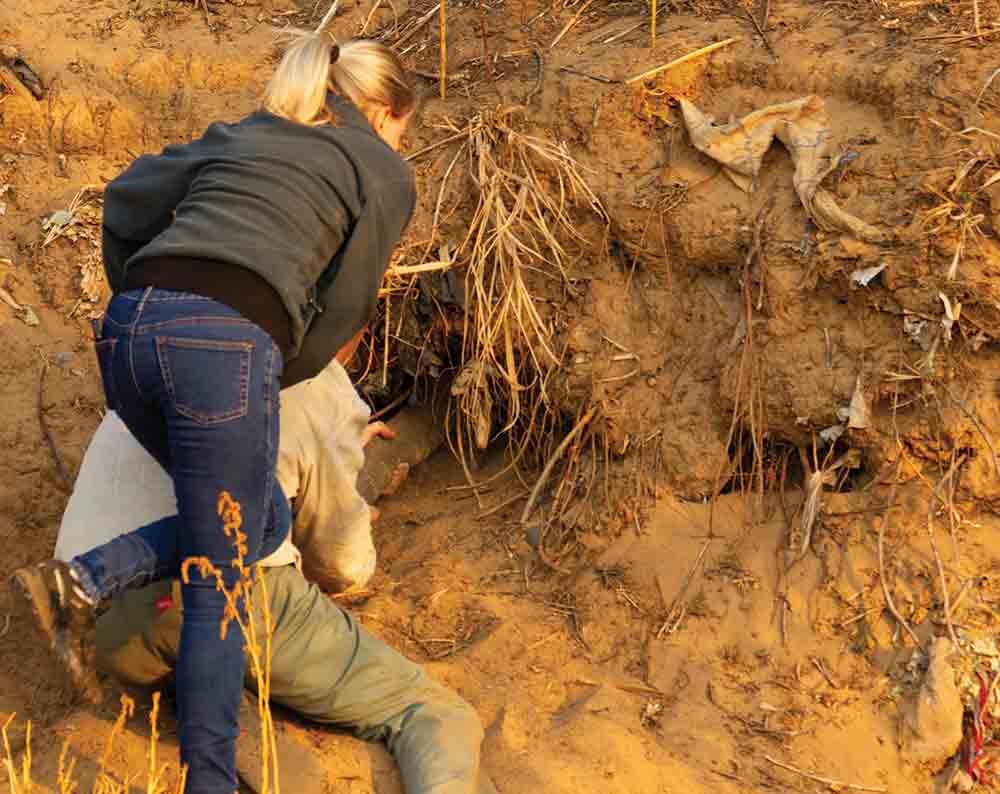
Kevin Gow removes the Nile monitor from its burrow. Photo by Dr. Ingrid Sellschop
Based on this experience, Kevin, Sue and I decided to team up and I would stake out the monitors at the river for a few days and alert them when it was time to attempt the rescue. With our first attempt, the monitor was warming itself up by basking in the morning sun, low down on the embankment. I notified Kevin, who left his work and came to implement the rescue mission.
Nile monitors are exothermic and rely on the weather and the sun to replace a functional body temperature. This species of monitor is known for having a high metabolic state and they are ferocious feeders, hunting on almost anything they can find, and hence, keeping a functional body temperature is vital for their survival.
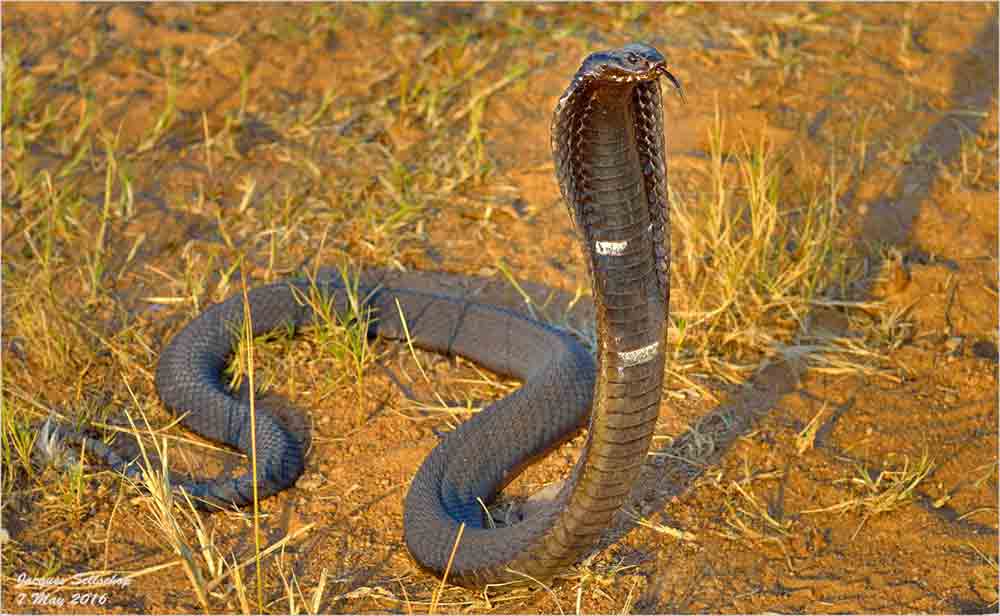
Spitting cobra. Photo by Jacques Sellschop
On his arrival at the river, Kevin approached the area by crawling through the thick foliage above the river, to reach the top of the embankment, so as to position himself directly above the spot where the monitor was basking. I proceeded to direct him from across the river as I was observing the monitor through the lens of my camera. Sue, waited in the background ready to assist.
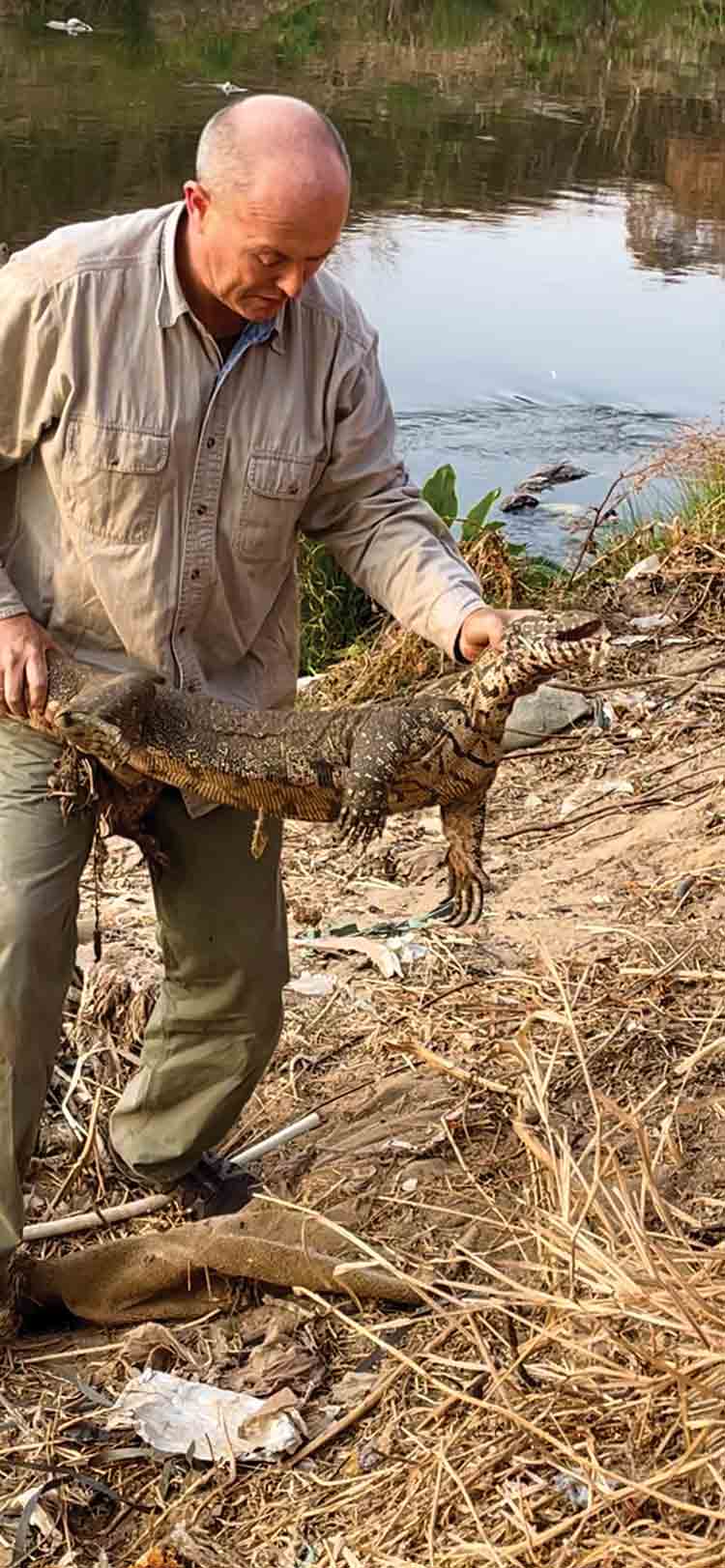
Kevin Gow captures the Nile monitor that had plastic wrapped around its neck. Photo by Dr. Ingrid Sellschop
As Kevin reached the edge of the sandy outcrop, he launched himself down onto the monitor, but unfortunately the monitor was too fast and moved off into the water below. We were very disappointed as implementing this type of rescue can be unpredictable and time consuming. Nevertheless, we were now even more determined to rescue the monitor. The following afternoon, I went down and spent three hours watching the group of monitors.
Once I had identified the one for rescue, with the noose around its neck, I once again called in Kevin and Sue to the rescue. This time, the monitor was higher up the embankment and half a meter away from its burrow. Kevin arrived and came around the river to where I was sitting observing the monitors. We assessed the position of the monitor and planned out our strategy of approach. The monitors, although quite habituated to the human presence along the river path every day as they walk their dogs or merely go for a fitness walk or run, are quite weary of any human stopping to observe them.
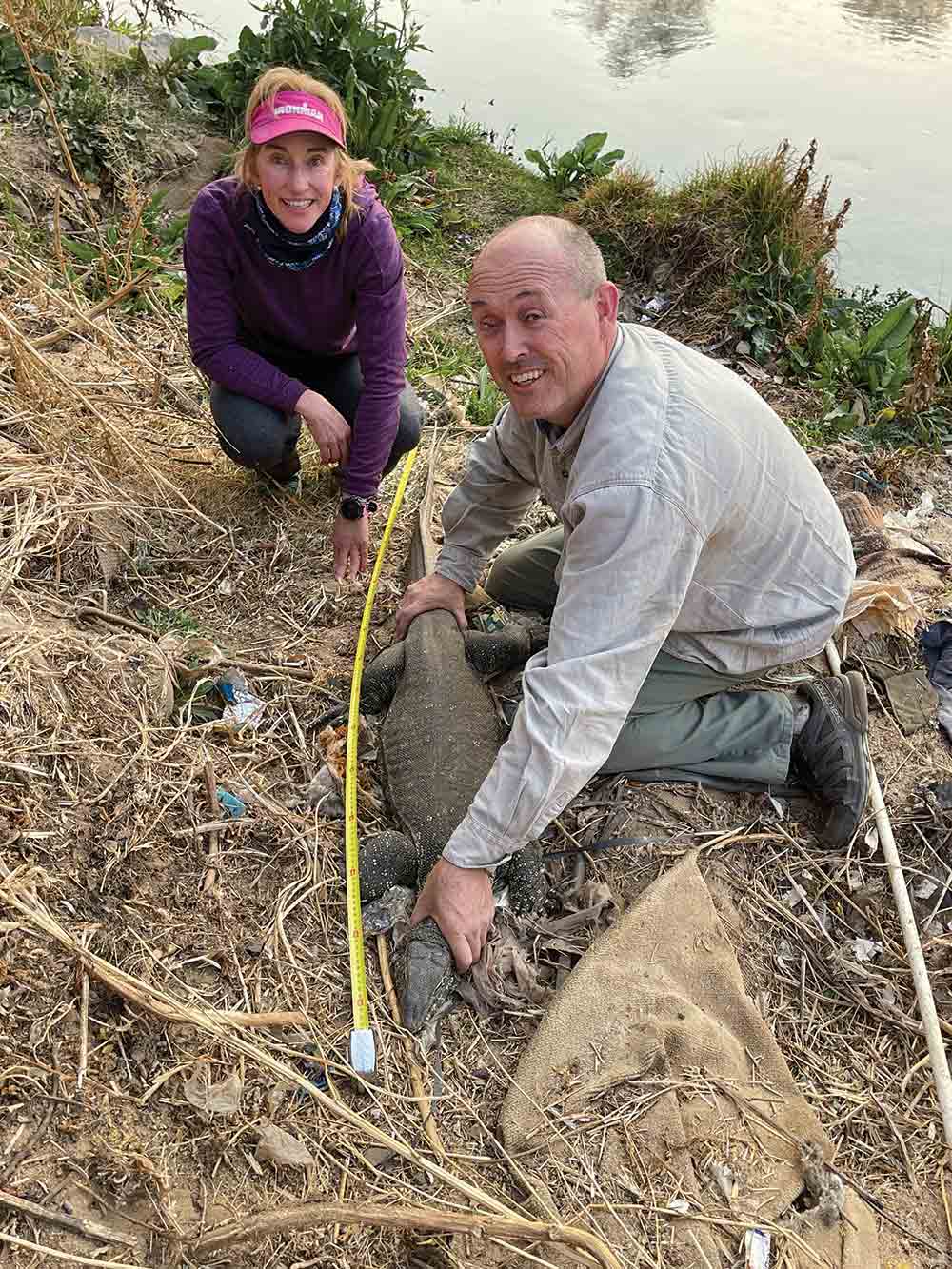
Kevin Gow’s stealth approach to the Nile monitor was successful. Photo by Dr. Ingrid Sellschop
It has taken me months for them to get used to my sitting or lying in the bushes across the river from their burrows, photographing and watching their activities and behavior. During the course of the three hours I spent observing them prior to our second rescue attempt, I saw a variety of activity along the river embankment, ranging from a Slender mongoose ( Herpestes sanguineus), which is a solitary hunter active during the day, running between the foliage and debris around the monitor burrows.
I did at the time think that it was quite brave to venture so close to the burrows, knowing how ferocious the monitors can be. I also observed interaction between younger Nile monitors and their “elders.” There was a lot of head nodding activity to ward off a younger monitor peeking into another monitor’s burrow. It really was such a privilege to spend the time in nature, watching the activities of these reptiles and other wildlife while on this rescue mission.
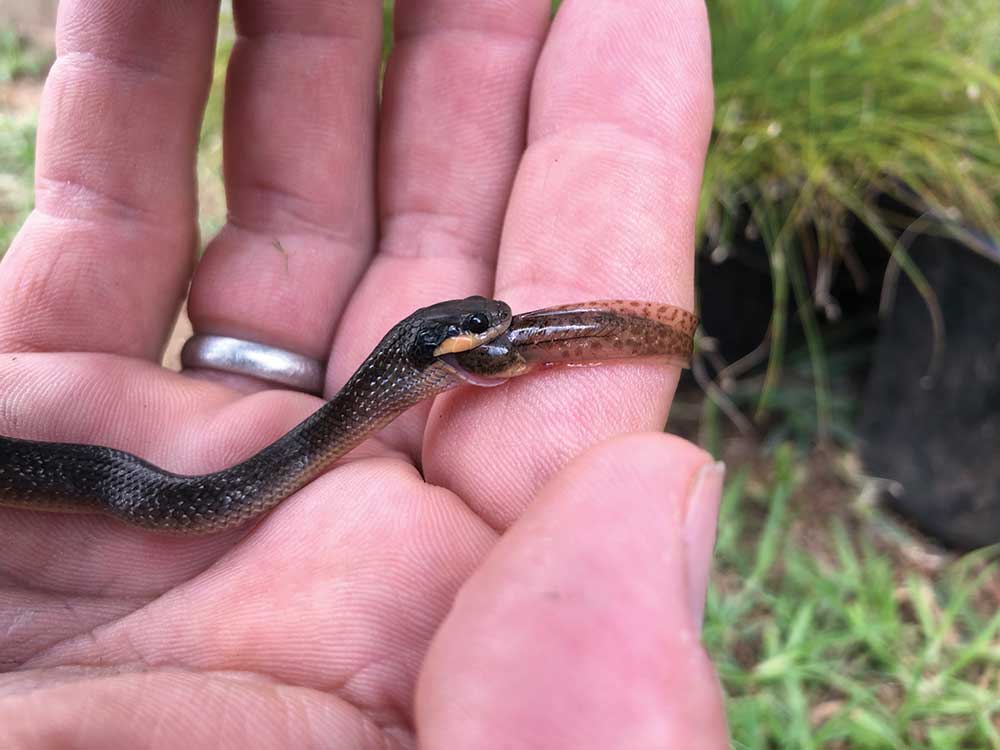
A red-lipped herald snake. Photo by Kevin Gow
Continuing on with the rescue mission, our newly planned strategy, based on the position of the identified monitor, was for me to direct Kevin as before, but this time he would launch himself as soon as the monitor was just about to enter the burrow and grab it by the tail. It worked! It was riveting to watch the actions of both the monitor, and Kevin diving off the embankment on to the monitor and grabbing its tail before it disappeared into the depths of its burrow.
Kevin struggled to hold on to the monitor’s tail and immediately screamed to Sue to come and assist him; he needed my help too and so I ran the 1.5 miles around the river to get to where they were holding onto the monitor. I felt like I was running a race of urgency, barely thinking about the fact that I had just thrown my professional camera and lens into my backpack before proceeding to burst into a sprint. Just before I reached them, Kevin managed to unhook the monitor’s back foot from within the burrow, and he and Sue log-rolled with the monitor down the embankment. Thankfully, they managed to hold onto the large monitor and missed landing in the river!
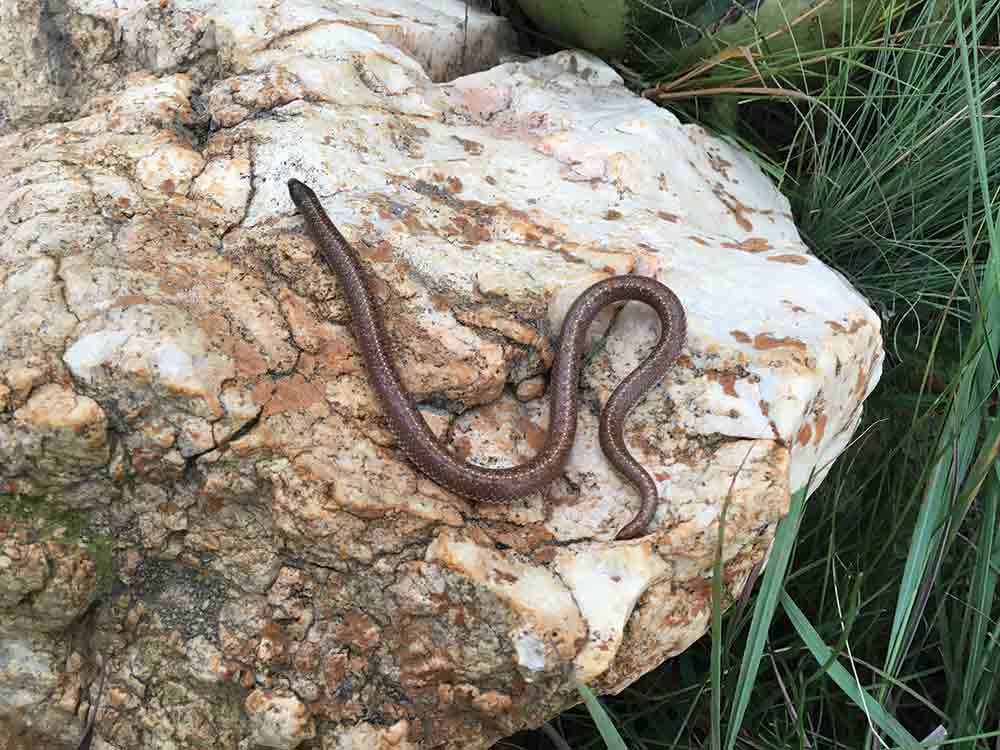
The Sundevals shovel snout snake (Prosymna sundevalli)is a non-venomous snake with a snout-like nose, not unlike that of a hognose snake. They can grow to 36cm in length and feeds on reptile eggs as well as small lizards and invertebrates. Photo by Kevin Gow
On my arrival from sprinting around the other side of the river, I was shaking and breathless from having an adrenalin rush and having had to run as fast as I could to help them. I was so relieved to arrive to see both of them holding the monitor down comfortably and safely as the monitor was no longer fighting to escape.
Kevin severed the tight noose from around the monitor’s neck with a pair of pliers, and we then had the pleasure of measuring it for research purposes and data collection, before Kevin released it. It measured at 2.05 meters (6 feet 8 inches) in length, a large monitor indeed! The release was also rather dramatic as we expected it to run forward into its burrow, but instead it came backwards toward Sue and I, almost knocking us over, before diving into the river below.
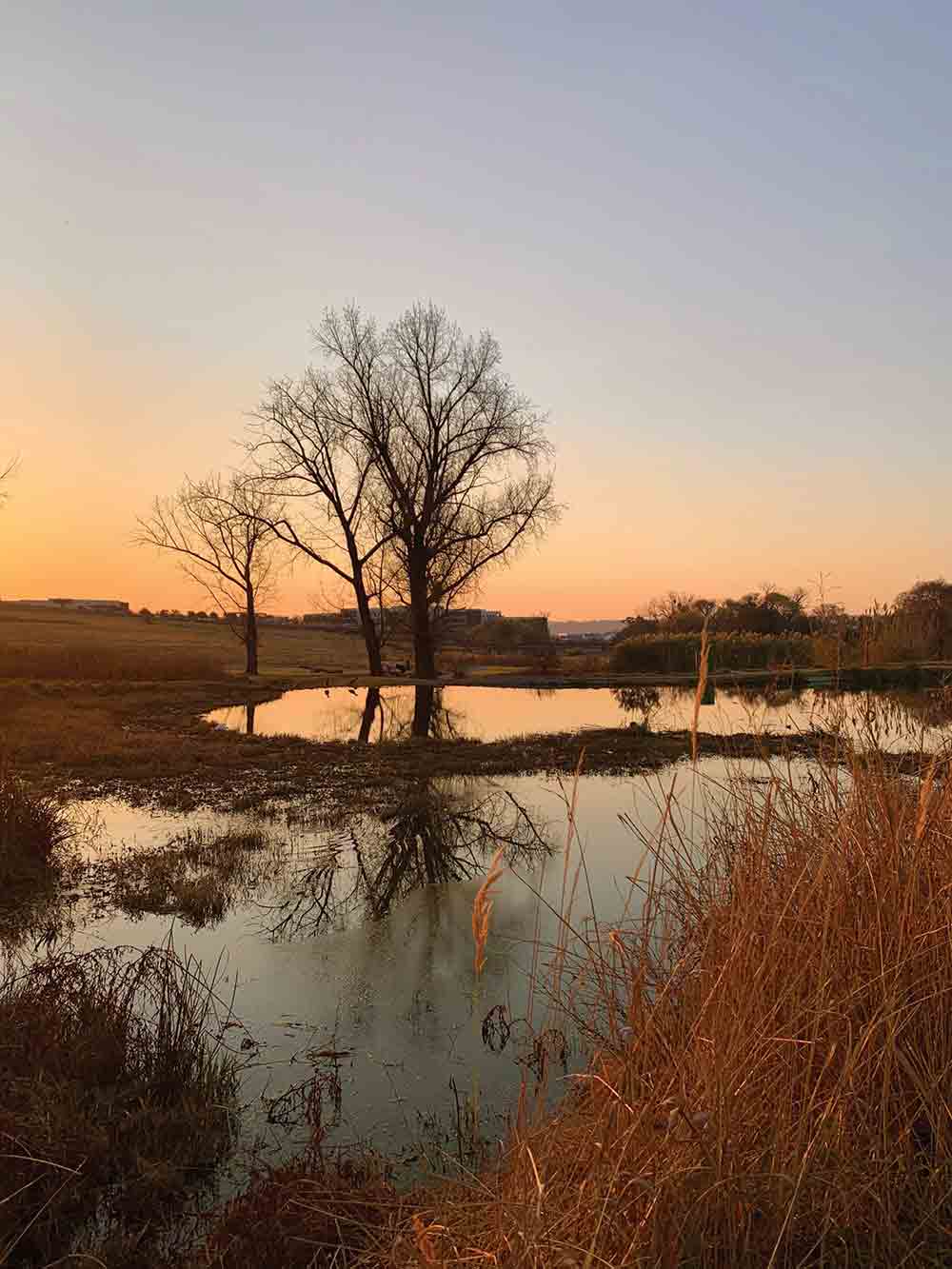
The Waterfall Estate is hope to a variety of reptiles and amphibians.
However, despite it being a hair-raising experience, we were all so happy and relieved that the monitor was safe and free to be able to feed and survive successfully.
We all learned a great deal from the rescue mission and have more knowledge now going forward for any other Nile monitor capture and release rescue missions within the estate.
Two days after the monitor’s rescue, I returned to observe the monitors in their habitat at the river, and I was grateful to see the monitor in question, basking happily outside of its burrow. It allowed me to photograph it once more before it moved off into its burrow.Through my telephoto lens, I could see the remains of a slight indentation on its neck from where the noose had been, but there was no wound at the time of the release so it wasn’t necessary to transport it to the wildlife vet.
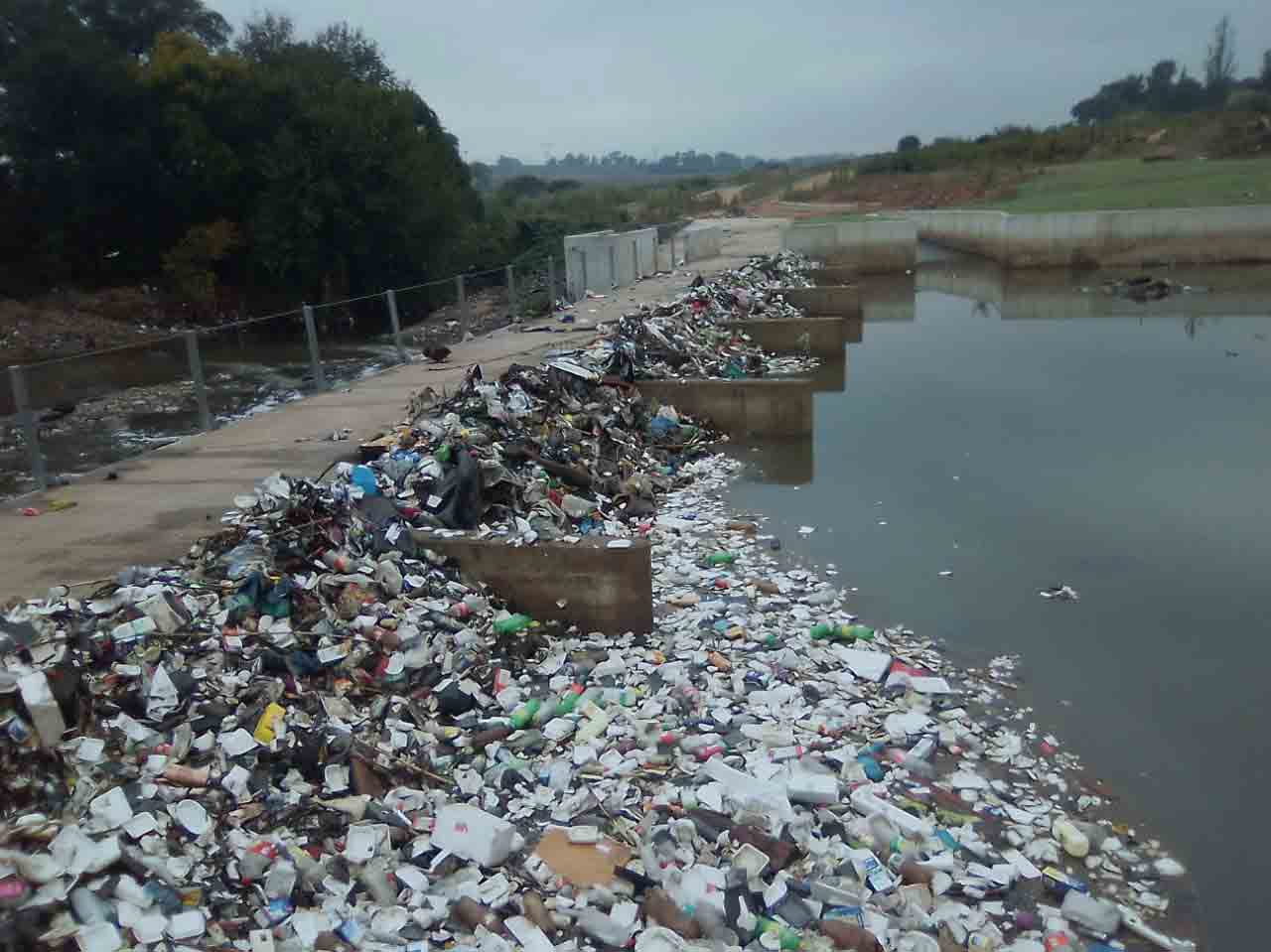
The litter trap near the estate. Plastic pollution is a worldwide problem. Photo by Dr. Ingrid Sellschop.
The litter problem, despite being greatly reduced since the building of the litter trap up river, continues to threaten the livelihood of reptiles and wildlife in the estate. Through this rescue mission, we have used it to make the residents of the estate more aware of the litter issue. The environmental council serving the estate continue to endeavor to reduce the litter problem so as to ensure a healthy ecosystem for all the reptiles and wildlife finding refuge in this protected wildlife estate.
Ingrid Sellschop is an active conservationist and wildlife photographer. Shee holds a doctoral degree in the field of physical therapy, which ironically has assisted in her passion and skills for conducting voluntary research in conservation. She has observed and photographed avian and amphibian behavior over the years, publishing articles in various nature and conservation focused magazines, as well as having her identification and photograph of the rare Pickersgill reed frog (Hyperolius pickersgilli) located in a nature reserve in Kwazulu Natal, South Africa, published in “The Book of Frogs” by Tim Halliday.

